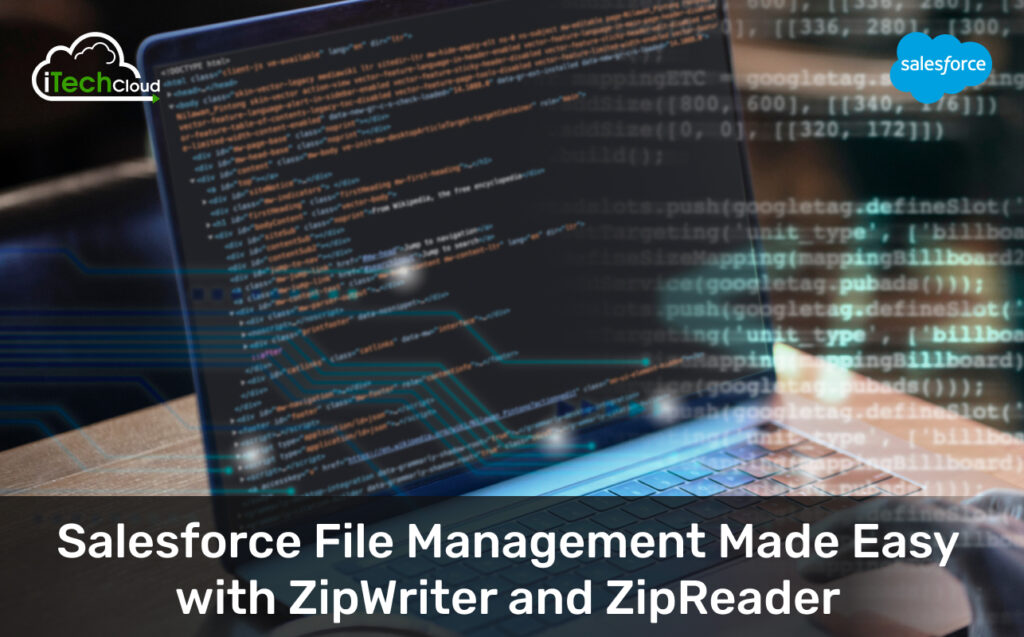Salesforce File Management Made Easy with ZipWriter and ZipReader

Introduction
Managing files efficiently in Salesforce is crucial for businesses that deal with large volumes of documents, attachments, and data. Whether it’s compressing files to save storage space, bundling multiple documents for easy distribution, or extracting archived data, Salesforce developers often need robust solutions to handle these tasks seamlessly.
Two powerful tools that simplify file management in Salesforce are ZipWriter and ZipReader. These utilities allow developers to create, read, and manipulate ZIP files directly within Salesforce, eliminating the need for external services or complex integrations.
By the end of this blog, you’ll have a deep understanding of how these tools can streamline file management in Salesforce and improve your organization’s efficiency.
Table of Contents
1. The Importance of File Management in Salesforce
Salesforce is widely used for CRM, customer support, and business automation, often requiring the handling of numerous files such as:
- Email Attachments (e.g., contracts, invoices)
- Documents (e.g., PDFs, spreadsheets)
- Images and Media Files (e.g., product photos, training videos)
- Data Exports (e.g., CSV, JSON backups)
Efficient file management helps in:
- Reducing Storage Costs – Compressing files saves space in Salesforce’s limited file storage.
- Improving Performance – Smaller files load faster, enhancing user experience.
- Simplifying Data Sharing – Bundling multiple files into a single ZIP makes distribution easier.
- Ensuring Compliance – Secure archiving helps meet data retention policies.
Without proper file management, organizations may face bloated storage, slower performance, and difficulties in retrieving documents.
2. Challenges with Handling Files in Salesforce
While Salesforce provides basic file storage (files, attachments, content documents), managing large or multiple files presents challenges:
- Storage Limits – Salesforce imposes storage restrictions, making it costly to store large files.
- Manual Compression – Users often resort to external tools to ZIP files, leading to inefficiencies.
- Bulk Operations – Handling multiple files individually is time-consuming.
- APEX Limitations – Native Apex lacks built-in ZIP functionality, requiring custom solutions.
- Security Risks – Moving files outside Salesforce for processing can expose sensitive data.
These challenges highlight the need for an integrated ZIP solution within Salesforce.
3. Introduction to ZipWriter and ZipReader
ZipWriter and ZipReader are Apex classes (often part of open-source or managed packages) that enable ZIP file operations directly in Salesforce.
What is ZipWriter?
- A utility that creates ZIP files from multiple Salesforce files (attachments, documents, blobs).
- Allows dynamic compression without external services.
What is ZipReader?
- A utility that extracts files from a ZIP archive stored in Salesforce.
- Enables reading and processing compressed data within Apex.
These tools eliminate dependency on third-party apps, keeping file processing secure and within Salesforce.
4. Key Features of ZipWriter
a) Create ZIP Files from Attachments
Combine multiple email attachments or files into a single ZIP.
b) Compress Large Files
Reduce file size for storage optimization.
c) Dynamic ZIP Generation
Generate ZIP files on the fly in Apex triggers, batches, or Lightning flows.
d) Support for Various File Types
Works with:
- Files (Salesforce Files)
- Attachments (from records)
- Static Resources
- Blob data (dynamically generated content)
e) No External Dependencies
Processes files entirely within Salesforce.
5. Key Features of ZipReader
a) Extract ZIP Files
Retrieve individual files from a ZIP stored in Salesforce.
b) Read Compressed Data
Access file contents without downloading externally.
c) Process Archived Files in Batches
Handle large ZIP files efficiently using batch Apex.
d) Validate ZIP Integrity
Check for corrupted or incomplete archives.
e) Secure File Access
Keep sensitive data within Salesforce instead of exporting.
6. Use Cases for ZipWriter and ZipReader
a) Automated Document Bundling
- Use Case: A legal team needs to send multiple contract PDFs as a single ZIP.
- Solution: Use ZipWriter to dynamically bundle files and attach them to an email.
b) Data Backup & Export
- Use Case: Export Salesforce records with attachments as a compressed backup.
- Solution: Generate a ZIP file containing CSV data and related documents.
c) Bulk File Uploads
- Use Case: Migrating files from an external system into Salesforce.
- Solution: Upload a ZIP, then use ZipReader to extract and store files in Salesforce.
d) Reducing Storage Costs
- Use Case: Compressing old case attachments to free up space.
- Solution: Schedule a batch job to ZIP and archive historical files.
e) Secure File Sharing
- Use Case: Distributing confidential reports externally.
- Solution: Password-protect ZIP files (if supported) before sharing.
7. Step-by-Step Implementation Guide
Step 1: Install Required Libraries
- If using an open-source solution, deploy the Apex classes (ZipWriter.cls, ZipReader.cls).
- For managed packages, install from the AppExchange.
Step 2: Create a ZIP File with ZipWriter
// Example: Compress multiple attachments into a ZIP
List<Attachment> attachments = [SELECT Id, Name, Body FROM Attachment WHERE ParentId = '001...'];
Blob zipBlob = ZipWriter.createZip(attachments);
// Save the ZIP as a new File
ContentVersion cv = new ContentVersion(
VersionData = zipBlob,
Title = 'CompressedFiles.zip',
PathOnClient = 'CompressedFiles.zip'
);
insert cv;
Step 3: Extract Files with ZipReader
// Example: Extract files from a ZIP stored in Salesforce
ContentVersion zipFile = [SELECT VersionData FROM ContentVersion WHERE Id = '068...'];
Map<String, Blob> extractedFiles = ZipReader.extractZip(zipFile.VersionData);
// Process each extracted file
for (String fileName : extractedFiles.keySet()) {
Blob fileData = extractedFiles.get(fileName);
// Save as Attachment, File, or process further
}
Step 4: Schedule Batch ZIP Processing (Optional)
// Batch Apex to compress old attachments
global class BatchZipAttachments implements Database.Batchable<sObject> {
global Database.QueryLocator start(Database.BatchableContext bc) {
return Database.getQueryLocator('SELECT Id, Name, Body FROM Attachment WHERE CreatedDate < LAST_YEAR');
}
global void execute(Database.BatchableContext bc, List<Attachment> scope) {
Blob zipBlob = ZipWriter.createZip(scope);
// Save ZIP and delete old attachments
}
global void finish(Database.BatchableContext bc) {
// Notify admin
}
}
8. Best Practices for File Compression in Salesforce
- Monitor Storage Usage – Regularly check file storage to avoid limits.
- Use Batch Processing – For large-scale operations, use Batch Apex.
- Avoid Duplicate ZIPS – Implement checks before creating redundant archives.
- Secure Sensitive Files – Encrypt ZIPs if handling confidential data.
- Test Performance – Ensure ZIP operations don’t hit governor limits.
9. Alternatives to ZipWriter and ZipReader
If these tools aren’t available, consider:
- External Cloud Services (AWS Lambda, Google Cloud Functions)
- Salesforce CPQ File Compression (for CPQ-specific needs)
- Third-Party Apps (DocuSign, Conga Composer)
However, external solutions add complexity and security risks.
10. Conclusion: Salesforce File Management
Salesforce file management becomes effortless with ZipWriter and ZipReader, enabling seamless compression, extraction, and organization of files without leaving the platform. These tools help optimize storage, improve performance, and streamline document workflows.
By implementing the strategies and code examples discussed, businesses can enhance their Salesforce file handling while maintaining security and efficiency.

